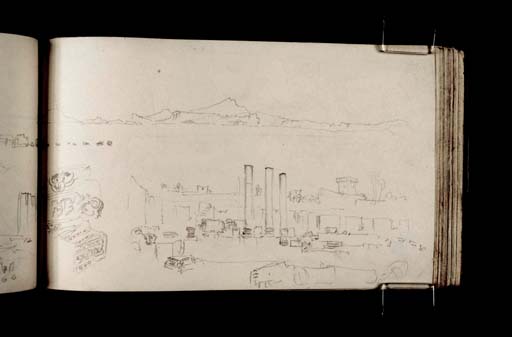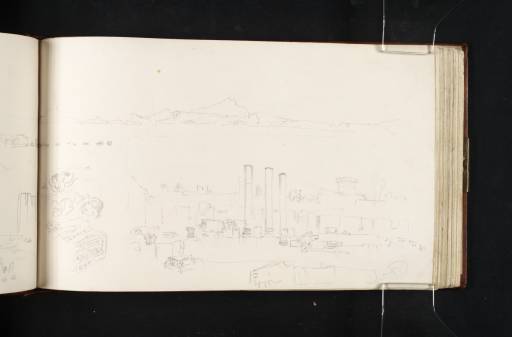Joseph Mallord William Turner The So-Called Temple of Serapis at Pozzuoli, and Details of its Decoration; and Part of a View of the Bay of Pozzuoli with the Ruins of Caligula's Bridge 1819
Image 1 of 2
-
 Joseph Mallord William Turner, The So-Called Temple of Serapis at Pozzuoli, and Details of its Decoration; and Part of a View of the Bay of Pozzuoli with the Ruins of Caligula's Bridge 1819
Joseph Mallord William Turner, The So-Called Temple of Serapis at Pozzuoli, and Details of its Decoration; and Part of a View of the Bay of Pozzuoli with the Ruins of Caligula's Bridge 1819 -
 Joseph Mallord William Turner, The So-Called Temple of Serapis at Pozzuoli, and Details of its Decoration; and Part of a View of the Bay of Pozzuoli with the Ruins of Caligula's Bridge 1819 (Enhanced image)Enhanced image
Joseph Mallord William Turner, The So-Called Temple of Serapis at Pozzuoli, and Details of its Decoration; and Part of a View of the Bay of Pozzuoli with the Ruins of Caligula's Bridge 1819 (Enhanced image)Enhanced image
Joseph Mallord William Turner,
The So-Called Temple of Serapis at Pozzuoli, and Details of its Decoration; and Part of a View of the Bay of Pozzuoli with the Ruins of Caligula's Bridge
1819
Joseph Mallord William Turner 1775–1851
Folio 72 Verso:
The So-Called Temple of Serapis at Pozzuoli, and Details of its Decoration; and Part of a View of the Bay of Pozzuoli with the Ruins of Caligula’s Bridge 1819
D15698
Turner Bequest CLXXXIV 70 a
Turner Bequest CLXXXIV 70 a
Pencil on white wove paper, 122 x 197 mm
Accepted by the nation as part of the Turner Bequest 1856
References
1909
A.J. Finberg, A Complete Inventory of the Drawings of the Turner Bequest, London 1909, vol.I, p.545, as ‘Ancient ruins’.
1984
Cecilia Powell, ‘Turner on Classic Ground: His Visits to Central and Southern Italy and Related Paintings and Drawings’, unpublished Ph.D thesis, Courtauld Institute of Art, University of London 1984, pp.180 note 42, 424, as ‘The Temple of Serapis at Pozzuoli, and details of its decoration’.
1987
Cecilia Powell, Turner in the South: Rome, Naples, Florence, New Haven and London 1987, p.79 note 35.
The so-called Temple of Serapis at Pozzuoli has been more recently identified as a macellum, or public market hall, originally comprising a porticoed courtyard surrounded by shops. The ruins, dating from the second century AD, are the subject of the lower sketch on this page. Turner has recorded the appearance of the site characterised by the three distinctive columns and has also made a more detailed study of an ornamental fragment of masonry. He is likely to have been familiar with other images of the ruins, for example a drawing by James Hakewill (1778–1843), Remains of the Temple of Jupiter Serapis, at Puzzuoli 1816 (British School at Rome Library).1
At the top of the page is part of a general view of the Bay of Pozzuoli which continues on the opposite sheet of the double-page spread, see folio 73 (D15699; Turner Bequest CLXXXIV 71). Visible in the distance is the island of Nisida with the distant Sorrentine peninsula. The line of dark blocks projecting out of the sea on the left represents the remains of the Roman breakwater of Pozzuoli, popularly known as the Bridge of Caligula. According to legend, Caligula constructed a floating pontoon of boats in order to disprove a prediction that he would no more become Emperor than ride across the Gulf of Baiae with horses. The bridge was three miles long and stretched between Pozzuoli (ancient Puteoli) and Baia. This story formed the subject of a later oil painting by Turner, Caligula’s Palace and Bridge exhibited 1831 (Tate, N00512).2 During the early twentieth century the surviving piers of the Roman structure were incorporated into the modern sea wall which stands today.
Nicola Moorby
June 2010
Reproduced in Tony Cubberley and Luke Herrmann, Twilight of the Grand Tour: A catalogue of the drawings by James Hakewill in the British School at Rome Library, Rome 1992, no.5.47, p.276. Other images include a watercolour by Abraham-Louis-Rodolphe Ducros (1748–1810), Temple de Jupiter Sérapis à Pouzzoles circa 1781 (Musée cantonal des Beaux-Arts, Lausanne), reproduced in colour in Pierre Chessex, Lindsay Stainton, Luc Boissonnas et al., Images of the Grand Tour: Louis Ducros, exhibition catalogue, Musée cantonal des Beaux-Arts, Lausanne 1985, no.31, colour plate IV.
How to cite
Nicola Moorby, ‘The So-Called Temple of Serapis at Pozzuoli, and Details of its Decoration; and Part of a View of the Bay of Pozzuoli with the Ruins of Caligula’s Bridge 1819 by Joseph Mallord William Turner’, catalogue entry, June 2010, in David Blayney Brown (ed.), J.M.W. Turner: Sketchbooks, Drawings and Watercolours, Tate Research Publication, December 2012, https://www

